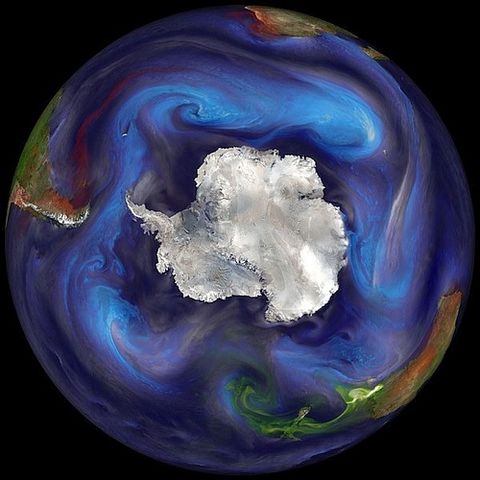It’s very simple: during glacial periods sea level decreases, exposed and dry deposits rich in iron and other nutrients. Wind raises dust in the air that she eventually falls into the sea and feeds phytoplankton, which sucks the atmosphere of carbon dioxide. When this greenhouse gas becomes very small, begins a new cooling and a new ice age. Phytoplankton slowly dying out, the ocean gradually returns carbon dioxide atmosphere, the world is warming, but in the meantime a new wind carries dust, laying the foundations for the next cold snap.
This hypothesis was formulated in the late 1980s, but until recently the overwhelming evidence to support it could not manage to get. Found only temporarily s e correlation between increasing concentration of saturated iron dust in surface waters and increased biological productivity.
Dust from Patagonia (reddish plume) saturates the water of the Southern Ocean, poor in nutrients. (Image NASA / Goddard Space Flight Center / William M. Putman / Arlindo M. da Silva.)
Paleoclimatology Alfredo Martinez Garcia of ETH Zurich and his colleagues have developed a new way of exploring the seabed sediments. Similar to the cores of organic material associated with certain carbonate skeletons foraminifera (these larger species compared to the other, and are easier to detect), or rather – nitrogen, the microorganisms which absorb in the form of nitrates dissolved in the water. The higher the proportion of heavy isotopes, the more surface water over the area were filled with life. Well, the age of a particular sample was determined by good old sediments radiocarbon dating.
The new method was applied to cores longer than 5 m, which packed more than 160 thousand years of history. It produced at the southwestern coast of South Africa. Windrose there is that there would have to shoulder the dust off the east coast of South America during the Ice Age and the reduction of sea and desert plains of Patagonia – in the interglacial epoch.
A strong correlation between the amount of dust on the biological productivity of the ocean surface and the amount of nitrate, dissolved in water and absorbed foraminifera. All these indicators have reached peaks in the last glacial period and during cold spells in between.
However, the biochemical parameters revealed by this study, only half explain fluctuations in the concentration of carbon dioxide between glacial periods and interglyatsialami, notices climatologist Andrew Watson of the University of Exeter (UK). It follows that, although ocean fertilization with iron does play an important role in the earth’s climate, this role is not the most important. It turns out that if we, as has been suggested, begin to saturate the ocean with iron in order to fight global warming, yet the fact that we have something to work. Growth of phytoplankton leads to the increase in the number of species that feed on them, and another question, what amount of carbon dioxide absorbed by phytoplankton sink to the bottom and remain in the sediment, and which will return to the breathing system by other marine life.
In glacial periods guilty iron

No comments:
Post a Comment